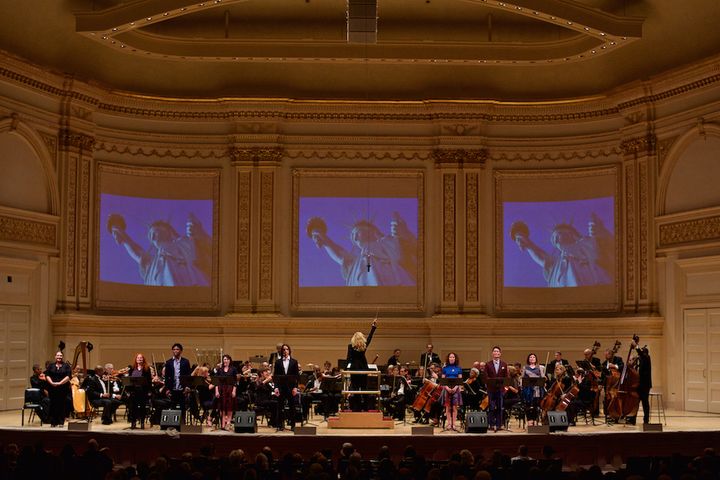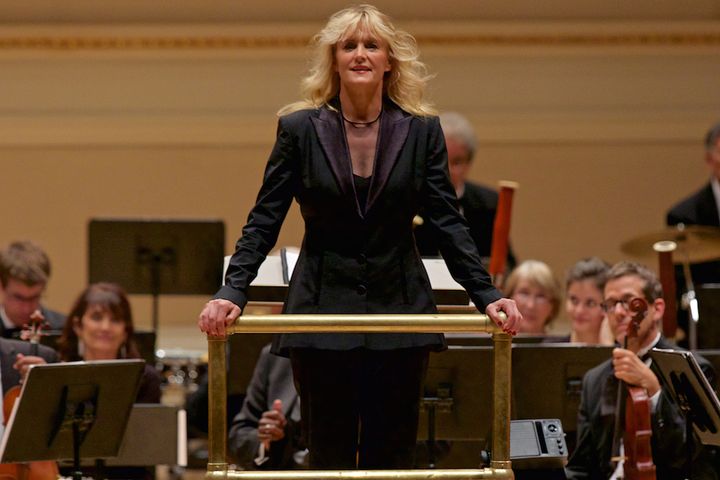
Conductor Amy Andersson and the Orchestra Moderne NYC at Carnegie Hall
By Brian Taylor, Contributing Writer, October 11, 2017
The world of live classical music faces existential challenges, as ticket-buying audiences dwindle, and orchestras across the country face financial hurdles. Evenings of film music abound in programming and orchestral tours are built around, of all things, video games.
The success of familiar and accessible programming has converged with an examination of diversity and inclusivity, to birth a new orchestral ensemble in New York, Orchestra Moderne NYC, founded by conductor Amy Andersson.
The ensemble’s debut concert, entitled The Journey to America: From Repression to Freedom (Part 1), served as an opening manifesto of Andersson’s vision and their stated mission of diversity, inclusivity, and cultural relevance. The program began with a piece by a female composer, and focused on music reflective of the immigrant experience. An interpreter for the deaf translated into American Sign Language.
Following hopeful introductory remarks by Karen Johal, a daughter of immigrants, the program began grandly with Overture to Light by Lolita Ritmanis, an Emmy-winning composer for film and television who specializes in scoring superhero-themed material.
This well-crafted programmatic overture remembers World War II Latvian refugees (including the composer’s parents), the liberation of Latvia from Soviet rule and the beloved National Library of Latvia, called the Castle of Light. This brightly hued natural concert opener was resplendent with lush, satisfying harmonies, and delicious emotional swells. The orchestra, under Andersson’s clear baton, played with verve and flair, and the piece climaxed with a lyrical trumpet solo played splendidly by John Sheppard.
Ritmanis’ compositional voice is firmly planted in the conservative tropes of Hollywood film scores, as if much of the twentieth century never happened. For some classical music listeners, this isn’t necessarily a bad thing, avoiding twelve-tone technique, serialism, and other methods of maximizing dissonance. Condescend as the cognoscenti may, Andersson might be on to something in focusing on music that is ‘approachable.’

Violinist Momo Wong with Orchestra Moderne NYC at Carnegie Hall
The concert proceeded with the world premiere of a new violin concerto by American composer Steven Lebetkin, a prolific composer and thinker on the subject of composition. Featuring the poised Momo Wong (herself an immigrant from Japan), the concerto received an expert first performance. However, both the piece’s relevance to the theme of immigration, and the quality of the work as a whole, is ambiguous.
The composer’s program notes detail his own immigrant heritage – both familial and musical. But much the same could be said of many a composer, and he describes the work as a concerto for both the violin and the orchestra “on level playing fields.” Unfortunately, the thickly scored orchestra and a sweet-toned solo violin were not on level playing fields in reality. The virtuoso’s fingers and bow flew around busily, but alas, frequently inaudibly as the orchestration overpowered. The long-winded piece proved a bit of a slog, rhythmically ponderous and texturally dense. The composer seemed to favor the platitudinous harmonic language of movie soundtracks, but without a demonstrable knack for melody or indelible harmony.
Following intermission, the brass section stood, and along with the percussion section, played Aaron Copland’s glorious Fanfare for the Common Man with dazzling skill and strength. If the rhythmic panache, warmth of tone, and impeccable intonation demonstrated in this reading are any indication, New York City has another first-rate classical ensemble on its hands.
This brief musical classic served as prelude to the evening’s main entree, Peter Boyer’s Ellis Island: The Dream of America, a work featuring seven actors reading interviews from the Ellis Island Oral History Project. The piece, enhanced by some characterful projected photographs, brings to mind a trip to the Ellis Island Museum. The superb cast of actors, each representing a different immigrant describing their experience, moved the audience with directness and humor. The piece is reminiscent of Copland’s Lincoln Portrait, both in structure and flavor, and sounds genuinely American. Although it adheres to the aesthetic of film music, it does so with ingenuity and generousness of feeling. The piece has been performed all over the country, and with good reason, as the judicious use of text and music alluringly speaks to human experience.

Conductor Amy Andersson with Orchestra Moderne NYC at Carnegie Hall
Amy Andersson and her Orchestra Moderne NYC have laid a solid foundation for their arrival in New York, and the orchestra plays magnificently, as if together for years. Andersson’s conducting is refreshingly no-nonsense and efficient. Her technique never draws attention to itself and she has a good ear and rich musicality. With a more perspicacious approach to programming, I expect Part 2 (although it is unclear when that will be presented) of The Journey to America will be a fascinating and compelling evening of accessible, yes, but moving and relevant art.
_________________________________
Brian Taylor is a contributing writer for ZEALnyc where he writes about classical music and theater performance.
Read more features from ZEALnyc:
For all the news on New York City arts and culture, visit ZEALnyc Front Page.
